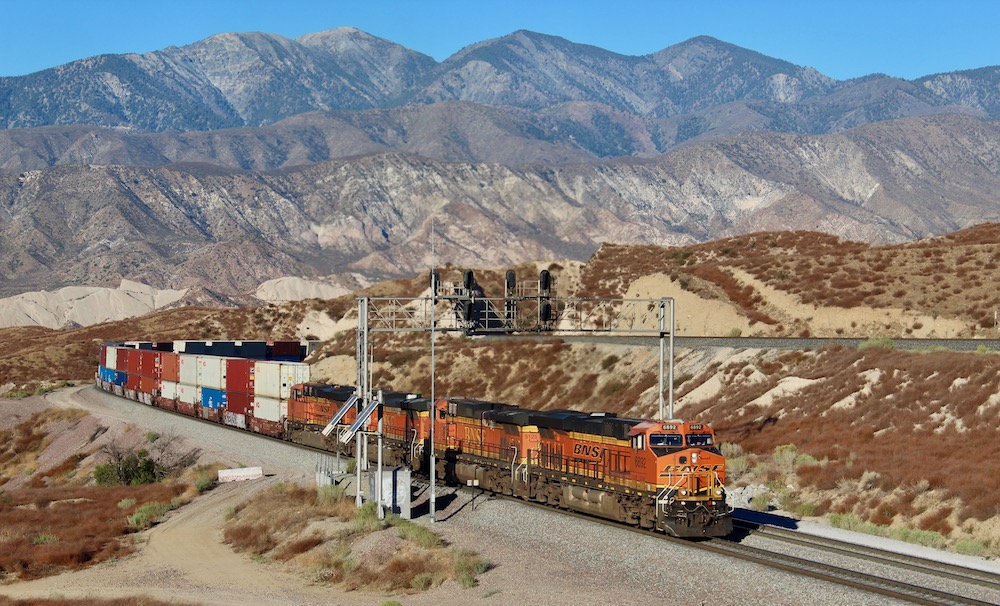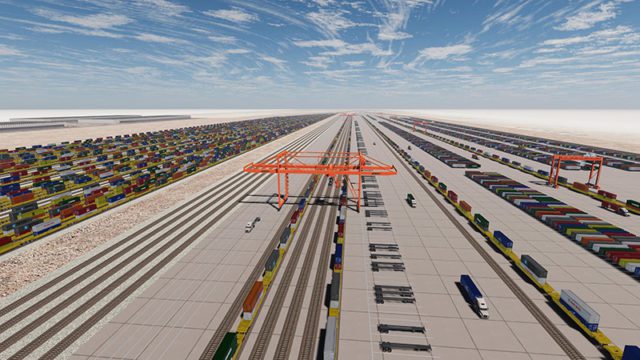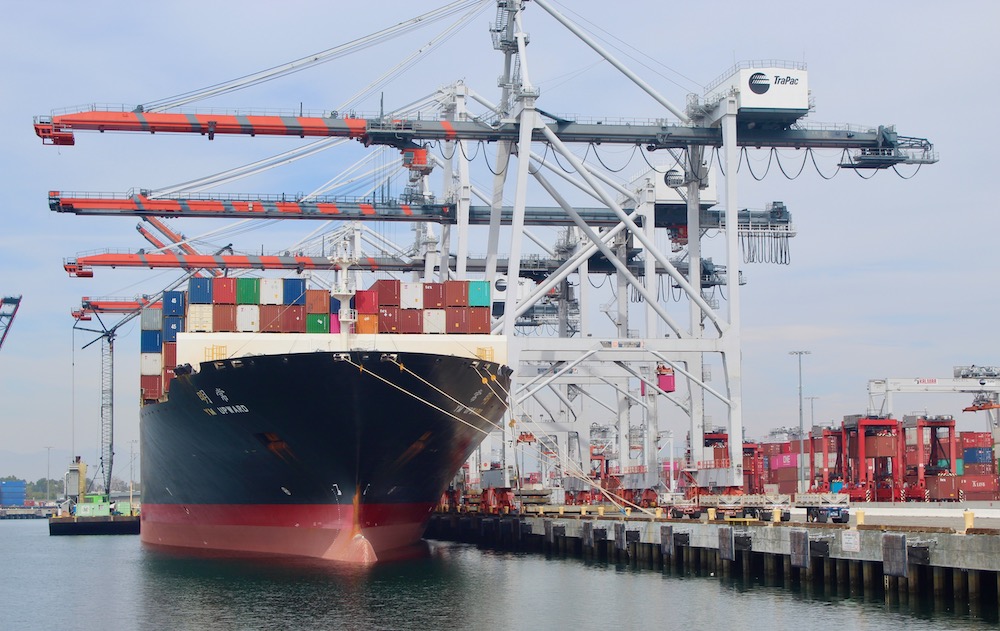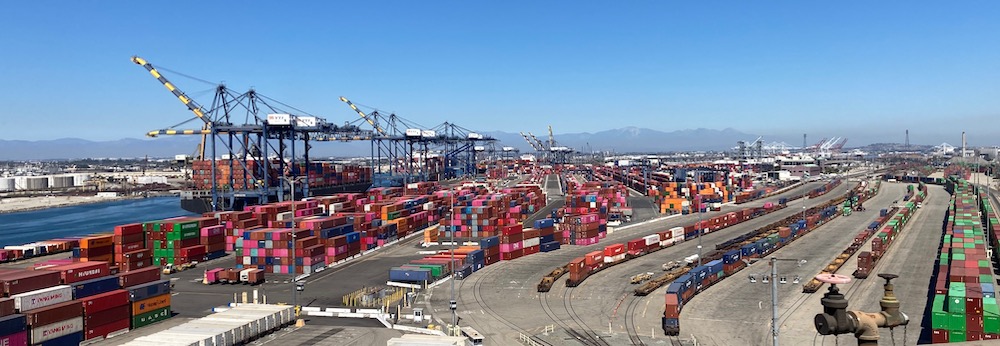
Can a railroad single-handedly preserve the intermodal dominance of North America’s biggest port complex? BNSF Railway is making a $1.5 billion bet that the answer is yes.
The railroad announced on Oct. 1 that it will build a massive new intermodal facility in Barstow, Calif., to expedite the handling of freight imported and exported through the ports of Los Angeles and Long Beach.
The stakes are high for the San Pedro Bay ports, which have seen their share of imported cargo fall over the past decade, a trend that was accelerated by pandemic-related congestion that made national headlines. The stakes are high for BNSF, too, because its intermodal fortunes are intertwined with how competitive the ports are.
Here’s why.
Many of the containers that land at the ports are bound for destinations outside of the L.A. Basin, mostly in the Midwest and Texas. The lion’s share of that freight rides BNSF stack trains to inland points.
These containers don’t have to enter the U.S. through L.A. and Long Beach. They could just as easily be routed to ports on the East Coast, Gulf Coast, or British Columbia. And that’s exactly what’s been happening.
The San Pedro Bay port complex has been losing market share to up-and-coming ports that have proven to be more fluid and less costly. BNSF’s new sorting hub — the Barstow International Gateway, or BIG for short — is designed to halt this trend and protect the railroad’s intermodal business.
BNSF has a knack for understatement. BIG is too small a word for a one-of-a-kind 4,500-acre facility that will be built on land BNSF owns on the dusty outskirts of Barstow, an important junction town with a long railroad history.

BIG will include an intermodal terminal, support yard, and warehouses where freight will be transloaded from international containers into domestic boxes before being put back on trains. At full buildout, BIG will be more than twice the size of BNSF’s sprawling logistics parks in Chicago and at Alliance, Texas. The facility will handle two million containers annually, a figure equal to 36% of BNSF’s 2021 intermodal volume.
The idea behind BIG is that it will reduce the amount of time containers spend waiting on the docks and eliminate the 80-mile dray moves for freight that’s currently trucked from the ports to the Inland Empire for transloading before being trucked to one of BNSF’s intermodal terminals for the trip east.
Currently, containers are taken off ships, stacked on the docks, and eventually loaded on well cars. Intermodal veteran Ted Prince notes that the largest ships can carry enough containers to fill seven trains. So some boxes have to wait for six trains to get loaded and depart before they get their chance to move inland. The process is so slow, he says, that freight transloaded into domestic container can arrive in Memphis before those long-lingering international boxes even leave the dock.


BIG promises to change this. Containers will be loaded directly from ship to rail. Existing BNSF trains will haul them through the Alameda Corridor and up the BNSF main to Barstow. Once there, the containers will take one of two paths. They’ll either be sorted by destination and loaded on eastbound trains or their cargo will be transloaded into domestic containers at on-site warehouses, then catch eastbound trains.

This will reduce congestion at the San Pedro Bay ports, effectively increasing their capacity and efficiency while nearly eliminating drayage costs for transload cargo. The ports say all this will make them more competitive with East Coast and Gulf Coast ports. And what’s good for the ports is good for BNSF.
Also in the railroad’s favor: BIG’s advantages may attract even more international container lines to BNSF’s rails. BIG will be a magnet for transload centers for big retailers like Walmart. And that, in turn, will feed the transload pipeline of BNSF intermodal partner J.B. Hunt.
BNSF will get an operational boost from BIG, too. BIG will assemble westbounds to match track lengths of BNSF’s terminals at Hobart and San Bernardino, which will reduce switching moves on the main.
There’s no timeline yet for construction, and BNSF says permitting may take a few years. But it’s clear that once BIG is up and running it could be a game-changer for BNSF, the only railroad you can imagine investing $1.5 billion in a single project.
You can reach Bill Stephens at bybillstephens@gmail.com and follow him on LinkedIn and Twitter @bybillstephens














If the Alameda Corridor is to become a quick transfer to Barstow, and given So Cal need to improve air quality; wouldn’t it make sense to electrify it? Use it to run many fixed length transfers. Also if this is so good for the port, why didn’t they come up with a straight out in the desert for both BNSF and UP and use the corridor as a sort of rapid transit for containers. This would free up lots of expensive high tax close in land for development. This seems like a perfect kind of public-private partnership opertunity.
Another point about the location near the new (1970’s) Barstow Yard is that the line from the Bay Area comes there too. That traffic can also be sliced and diced at BIG.
All this happy talk about BIG supposes imports from China (the vast majority) and east Asia remain stable or increase. Given the state of geopolitics, I am not sure what the state of globalized trade and supply chains might look like. Surely 10 years ago few were thinking about a trade war with China, a hot proxy war with Russia and the huge changes in the energy markets. China’s military power will challenge the US in the coming decade, while the US struggles on multiple fronts.
Mr. Spindler not sure your comments are especially relevant. Everyone in North America is making more or less the same bet as BNSF is making in Barstow. Canada, Mexico, east coast, west coast, take your pick, are all making the same kinds of large-scale infrastructure investments to handle imports. The reality is that southern California is built out and everything is landlocked.
Since I was personally involved with the border business at Santa Fe, I would point out that San Diego remains the second busiest border crossing after Laredo and the largest one without direct rail intermodal service. I still think Barstow’s operational capacity may hold the key to solving that conundrum.
Your border crossing information if refering to freight is incorrect.. After Laredo Detroit is the 2nd busiest border crossing for freight. When it comes only to Mexican crossings El Paso is the second busiest.
The discussion had been about the US-Mexico border. Barstow is a lot closer to Mexico than Canada. BTS data for 2019 gives Otay Mesa a slight edge in volume (less than one percent share) over El Paso. BTW what happened to your theory about short haul rail not being viable? Looks like BNSF didn’t get your memo.
Next time put context behind busiest crossing’s… BTS data from 2021 is available. Otay Mesa is at 3rd place now.. My theory still holds.. Outisde a microcosm of short haul intermodal. Is there massive CAPEX planned for new terminals to capture these short hauls? An don’t mention anecdotal low hanging fruit of subsidized port to inland port moves… IS BNSF or anyone else planning on challenging trucks in the market at an average haul of 524 miles(Dry Van and Reefer)for domestic rail serivce? Not hook and haul transloaded ocean freight? ….. Didn’t think so.. …
I recall a previous comment you mentioned me in about BNSF starting SHIM Port Houston to DFW.. I guess you missed when UP ran service in the same lane and bowed out…. Hmmm I wonder why?…
I’ve gained $17,240 only within four weeks by comfortably working part-time from home. Immediately when I had lost sxs my last business, I was very troubled and thankfully I’ve located this project now in this way I’m in a position to receive thousand USD directly from home. Each individual certainly can do this easy work & make more greenbacks online by visiting
following website…..>>> https://careerboost01.blogspot.com/
@Richard Andre International containers are either 20 or 40 feet long. I don’t believe there are any 45s or 48s.
If containers are loaded mill run to BIG, what of the pieces that are either direct to customers in the Basin, or are transloaded in the basin? Will they ride a train back to the Basin? Or be drayed?
So there is indeed an initial sort at the Ports – even as there is now, between the various local destinations. The pieces are placed in destination-related stacks at the Ports. About 30-35% go directly from the Ports by rail.
There is much transloading of pieces at warehouses, from 40-foor International to 53-foot domestic. In that process, the goods themselves are sorted at the warehouse, even as UPS sorts its shipments at its internal hubs.
$1,500,000,000 is a very big bet on continued congestion at the Ports – which doesn’t seem to be happening now. Today, it is Savannah that is congested. Tomorrow? Who knows? The economics of riding a vessel all the way to the east coast from the East is not pretty.
Vessels want to call at LA and LB because there are – what? – 30,000,000? – people living within 300 miles of the Ports.
Interesting commentary Mr. Fuller but let’s look at the actual record for the last 30 years.
Start with the JBH deal in 1989, then the UPS deal at Willow Springs two years later. Both were major paradigm shirts in the right direction.
Followed by the Alliance – Hillwood deal the next year. It’s called a Logistics Park.
Krebs loses out on NS and CN as merger partners but in 2002 Mike Mullen and CenterPoint come along make them an offer they can’t refuse on LPC.
Fast forward about 10 years to the Abo Canyon project combined with the Eastern Kansas doubletrack project and BNSF ends up with the first and only double track mainline between Chicago and LA. (Like the song says, ‘all the way to Cali-forn-iay.’)
Then BNSF buys back the MRL-NP trackage.
In 1996 Krebbs tries to get Mr. Buffet to buy BNSF. He fails but about 15 years later Matt Rose is successful. (And who cares about what Union Pacific did or did not do.)
“In the days to come the Goddess of Victory will bestow her laurels only on those who are prepared to act with daring.”
So I guess I didn’t know exactly how this is done. International containers are 20, 40 and 45 feet long, 8 feet wide and 8.5 or 9.5 feet high (22 pallets GWR 44,000). Domestic containers are 48 and 53 feet long, 8.2 feet wide and 9.5 feet high (26 pallets GWR 43,500). So I knew they are different but never realized that they have to actually transload between the two at a warehouse somewhere. That seems like a rather weak link in the efficiency of the supply chain.
I have to wonder if using 45 foot ISO containers exclusively would be more efficient. It would have to move things along much quicker. Transloading all of those containers would seem rather laborious.
This kind of reminds me of when BN built into the Powder River Basin in the 1970s. The new BN had no shortage of potential capital projects and chose to spend a huge amount on one project. I hope this pays off as well as that one did!
Mr. Rowell you may be interested in the views of Matt Rose here. In his last address before the Winter Meeting of the Midwest Association of Rail Shippers in Chicago. Matt said, “we’ll never get our money out of the Powder River Basin”. PRB coal needed up being a very high maintenance operation with long term limits on revenues.
Matt Rose has been one of the most consistently honest of rail leaders
intermodal shipment sure is booming
This would be a good first step — assuming California regulators are a lot more timely than they have shown. However, what is also needed to unclog the two ports is for the union to agree to international port procedures — 24 hour 7 day a week operation and full automation. Unfortunately, the latter is less likely than the former.
Interesting analogy Mr. Landey. Not bad for an amateur.
BIG also gives BNSF and JBH the ability to serve the growing southern Nevada logistics market.
It also provides an opportunity to reopen the San Diego terminal. Our problem there 30 years ago was the inability to sort by at origin by destination. Now we can mine-run everything out to Barstow and sort there. Let’s start taking some trucks off I-5 and I-15.
BIG can also facilitate substituted highway service (IMX) for the produce and wine shippers at Fresno and Modesto. JBH now operates the largest fleet of refrigerated containers in the industry.
BIG is also a great place to store chassis and empty containers regardless of ownership.
BIG opens up a world of possibilities…
My cat Burlington Northern Santa Fe (he answers to “Burlington” and comes when he’s called) never stops reminding me that BNSF is run by very smart people. There is an article in today’s Wall Street Journal about the twin ports at San Pedro Bay (Los Angles and Long Beach). These have been seeing small declines compared to other ports on the various coasts of North America. These ports may decline slightly but they aren’t closing down.
The point of BIG is that containers have to be sorted somewhere. A ship that carries containers from overseas doesn’t care where in America the individual boxes ultimately go. That’s a problem for Americans to figure out. What BNSF is saying is this: get the containers out of the docks as fast and as cheaply as you can. Sort them somewhere else.
The postal clerk who collects posted mail at a drop box doesn’t sort them by destination. He doesn’t even look at them. He trucks them to a building where the sorting will begin. Ditto, my neighborhood FedEx store doesn’t sort the packages people drop off — instead these packages are gotten onto a truck to be sorted somewhere else. That’s what BNSF is saying